Network chips maker MACOM Technology Solutions (NASDAQ: MTSI) reported results in line with analysts' expectations in Q1 CY2024, with revenue up 7% year on year to $181.2 million. The company expects next quarter's revenue to be around $190 million, slightly above analysts' estimates. It made a non-GAAP profit of $0.59 per share, down from its profit of $0.79 per share in the same quarter last year.
MACOM (MTSI) Q1 CY2024 Highlights:
- Revenue: $181.2 million vs analyst estimates of $180.9 million (small beat)
- EPS (non-GAAP): $0.59 vs analyst expectations of $0.59 (in line)
- Revenue Guidance for Q2 CY2024 is $190 million at the midpoint, above analyst estimates of $188.2 million
- Gross Margin (GAAP): 52.5%, down from 60.6% in the same quarter last year
- Inventory Days Outstanding: 188, down from 208 in the previous quarter
- Free Cash Flow of $13.07 million, down 54% from the previous quarter
- Market Capitalization: $7.14 billion
Founded in the 1950s as Microwave Associates, a communications supplier to the US Army Signal Corp, today MACOM Technology Solutions (NASDAQ: MTSI) is a provider of analog chips used in optical, wireless, and satellite networks.
MACOMs peers and competitors include Analog Devices (NASDAQ:ADI), Texas Instruments (NASDAQ:TXN), Skyworks (NASDAQ:SWKS), Infineon (XTRA:IFX), NXP Semiconductors NV (NASDAQ:NXPI), Monolithic Power Systems (NASDAQ: MPWR), Marvell Technology (NASDAQ:MRVL), and Microchip (NASDAQ:MCHP).Analog Semiconductors
Longer manufacturing duration allows analog chip makers to generate greater efficiencies, leading to structurally higher gross margins than their fabless digital peers. The downside of vertical integration is that cyclicality can be more pronounced for analog chipmakers, as capacity utilization upsides work in reverse during down periods.
Sales Growth
MACOM's revenue growth over the last three years has been unimpressive, averaging 3.5% annually. As you can see below, this was a weaker quarter for the company, with revenue growing from $169.4 million in the same quarter last year to $181.2 million. Semiconductors are a cyclical industry, and long-term investors should be prepared for periods of high growth followed by periods of revenue contractions (which can sometimes offer opportune times to buy).
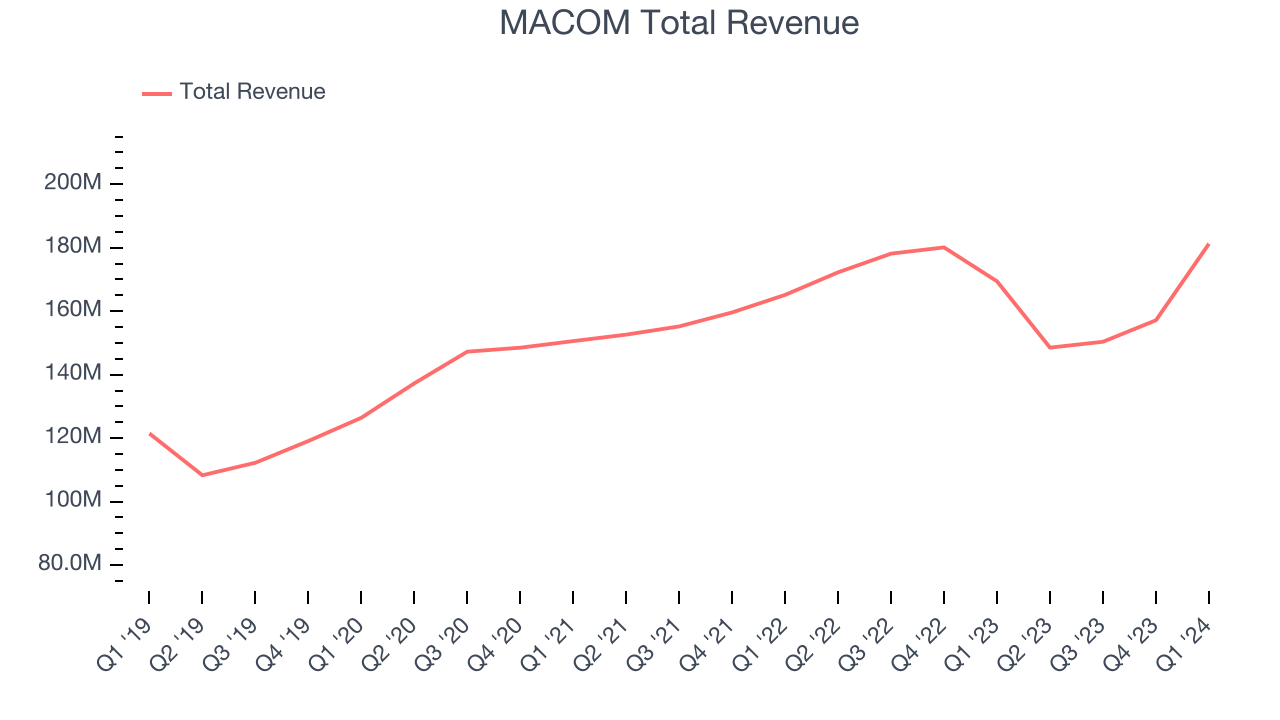
While MACOM was in line with analysts' revenue estimates, this was a sluggish quarter for the company as its revenue only grew 7% year on year. MACOM's growth, however, flipped from negative to positive this quarter. This encouraging sign will likely be welcomed by shareholders.
MACOM returned to positive revenue growth this quarter and its management team expects the trend to continue. The company is guiding to 27.9% year-on-year growth next quarter, and analysts seem to agree, forecasting 26% growth over the next 12 months.
Product Demand & Outstanding Inventory
Days Inventory Outstanding (DIO) is an important metric for chipmakers, as it reflects a business' capital intensity and the cyclical nature of semiconductor supply and demand. In a tight supply environment, inventories tend to be stable, allowing chipmakers to exert pricing power. Steadily increasing DIO can be a warning sign that demand is weak, and if inventories continue to rise, the company may have to downsize production.
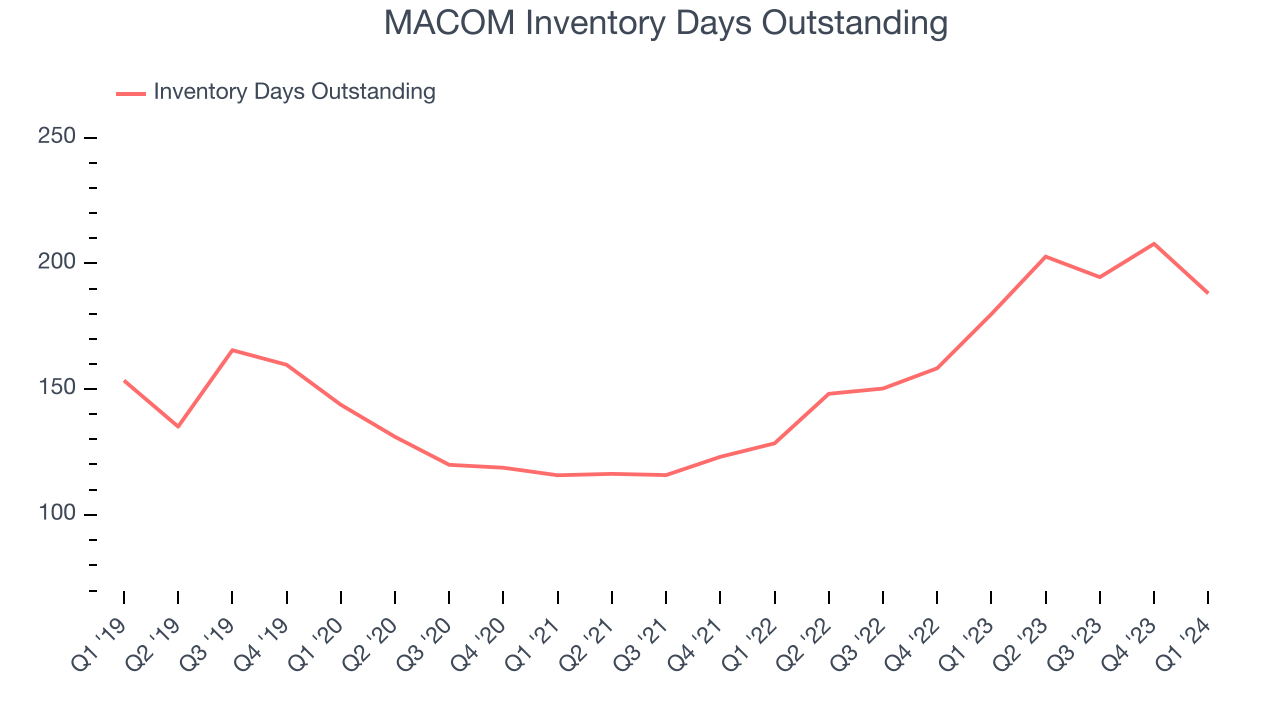
This quarter, MACOM's DIO came in at 188, which is 38 days above its five-year average. These numbers suggest that despite the recent decrease, the company's inventory levels are higher than what we've seen in the past.
Pricing Power
In the semiconductor industry, a company's gross profit margin is a critical metric to track because it sheds light on its pricing power, complexity of products, and ability to procure raw materials, equipment, and labor. MACOM's gross profit margin, which shows how much money the company gets to keep after paying key materials, input, and manufacturing costs, came in at 52.5% in Q1, down 8.1 percentage points year on year.
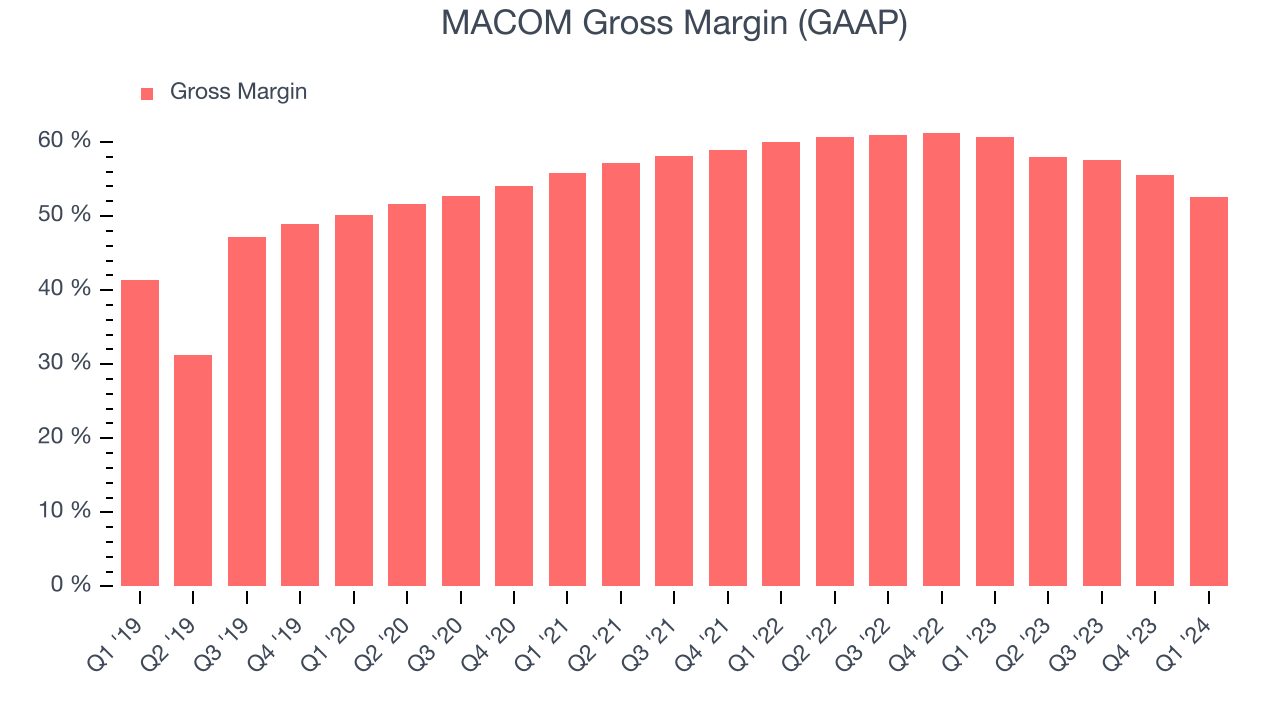
Despite declining over the last 12 months, MACOM still retains reasonably high gross margins, averaging 55.7%. These margins point to its solid competitive offering, disciplined cost controls, and lack of significant pricing pressure.
Profitability
MACOM reported an operating margin of 22.2% in Q1, down 11.2 percentage points year on year. Operating margins are one of the best measures of profitability because they tell us how much money a company takes home after manufacturing its products, marketing and selling them, and, importantly, keeping them relevant through research and development.
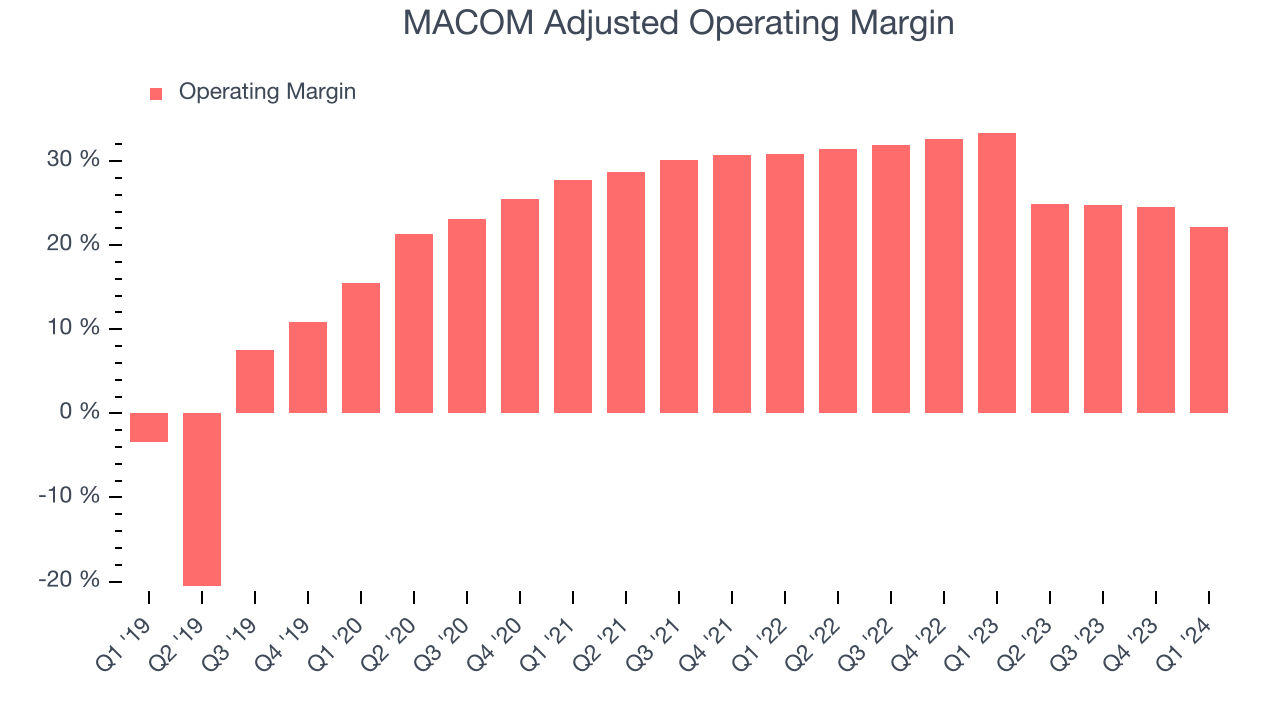
MACOM's operating margins have been trending down over the last year, averaging 24%. This is a bad sign for MACOM, whose margins are already below average for semiconductor companies. To its credit, however, the company's margins suggest modest pricing power and cost controls.
Earnings, Cash & Competitive Moat
Analysts covering MACOM expect earnings per share to grow 30.5% over the next 12 months, although estimates will likely change after earnings.
Although earnings are important, we believe cash is king because you can't use accounting profits to pay the bills. MACOM's free cash flow came in at $13.07 million in Q1, down 50.6% year on year.

As you can see above, MACOM produced $128.6 million in free cash flow over the last 12 months, an impressive 20.2% of revenue. This is a strong result; MACOM's free cash flow conversion was higher than most semiconductor companies, and if it can maintain this level of cash generation, it can invest in plenty of new and existing products to ride out cyclical downturns more easily.
Return on Invested Capital (ROIC)
EPS and free cash flow tell us whether a company was profitable while growing revenue. But was it capital-efficient? A company’s ROIC explains this by showing how much operating profit a company makes compared to how much money the business raised (debt and equity).
MACOM's five-year average ROIC was 5.5%, somewhat low compared to the best semiconductor companies that consistently pump out 35%+. Its returns suggest it historically did a subpar job investing in profitable business initiatives.
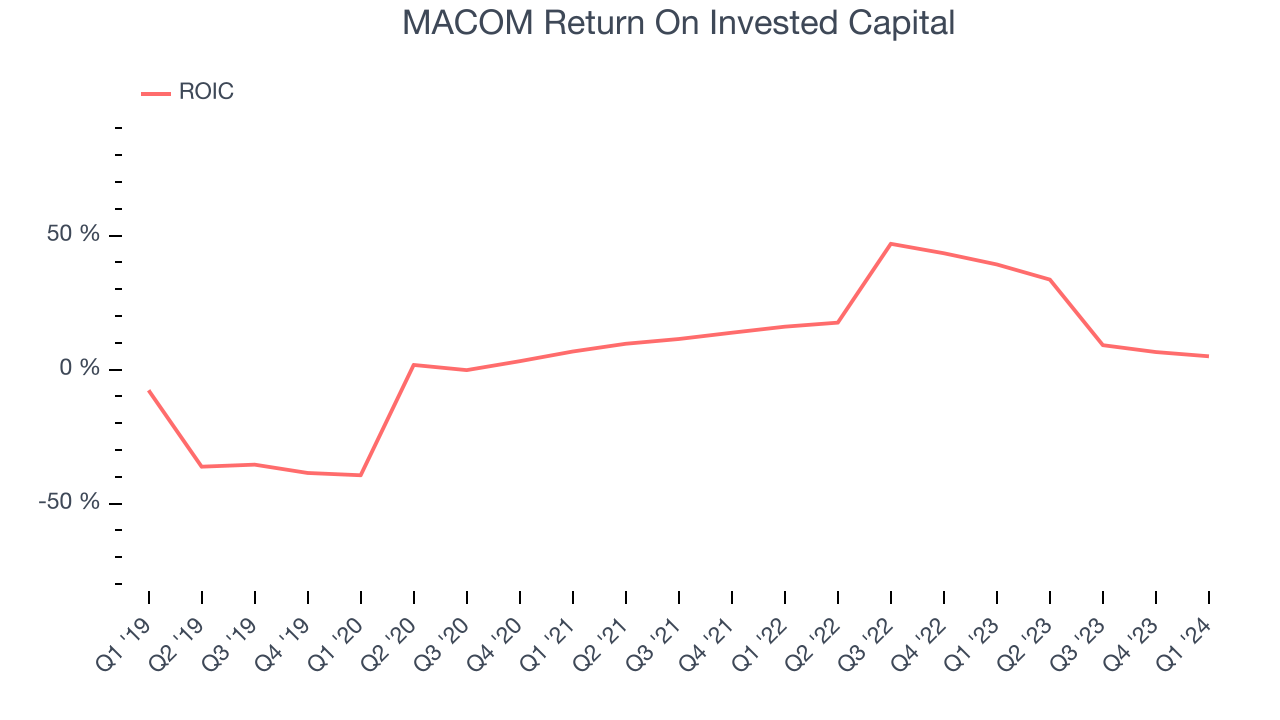
The trend in its ROIC, however, is often what surprises the market and drives the stock price. Over the last few years, MACOM's ROIC has significantly increased. This is a good sign, and if the company's returns keep rising, there's a chance it could evolve into an investable business.
Key Takeaways from MACOM's Q1 Results
We were impressed by MACOM's strong improvement in inventory levels. We were also glad next quarter's revenue and EPS guidance were slightly higher than Wall Street's estimates. On the other hand, its operating margin regrettably fell and its gross margin shrunk. Overall, this was a mediocre quarter for MACOM. The stock is up 1.1% after reporting and currently trades at $100.13 per share.
Is Now The Time?
MACOM may have had a bad quarter, but investors should also consider its valuation and business qualities when assessing the investment opportunity.
Although we have other favorites, we understand the arguments that MACOM isn't a bad business. Although its revenue growth has been weak over the last three years with analysts expecting growth to slow from here, its strong free cash generation allows it to sustainably invest in growth initiatives. Investors should still be cautious, however, as its relatively low ROIC suggests it has struggled to grow profits historically.
MACOM's price-to-earnings ratio based on the next 12 months is 33.4x. We don't really see a big opportunity in the stock at the moment, but in the end beauty is in the eye of the beholder. And if you like the company, it seems that MACOM doesn't trade at a completely unreasonable price.
Wall Street analysts covering the company had a one-year price target of $98.39 per share right before these results (compared to the current share price of $100.13).
To get the best start with StockStory check out our most recent Stock picks, and then sign up to our earnings alerts by adding companies to your watchlist here. We typically have the quarterly earnings results analyzed within seconds of the data being released, and especially for the companies reporting pre-market, this often gives investors the chance to react to the results before the market has fully absorbed the information.
